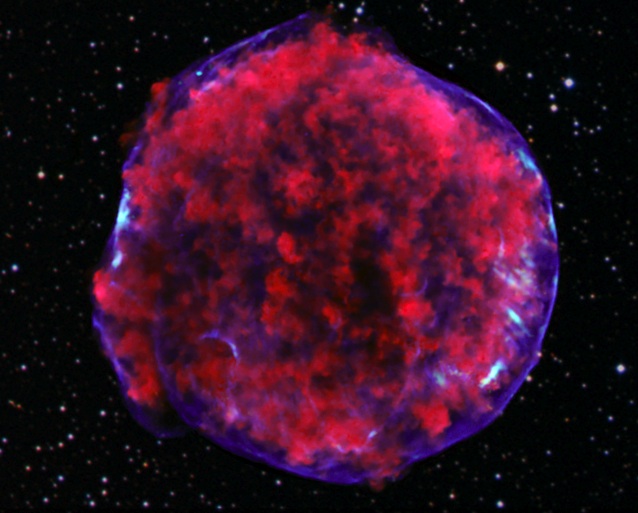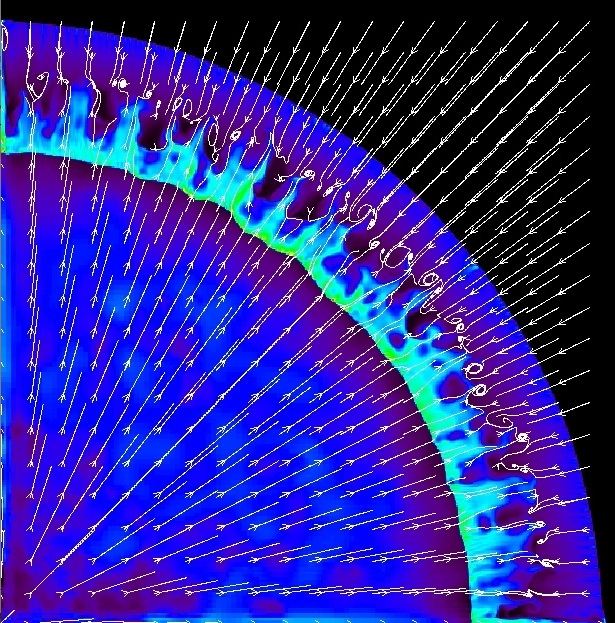| 3-D evolution of supernova remnant |
 For the first time, in a collaboration with CEA/Saclay (France) and University of Zürich (Switzerland), we have performed comprehensive 3D numerical simulations of the remnants of the supernova explosion in the presence of energetic particles (Fraschetti et al. 2010). Our simulations quantified the effect of accelerated particles at the forward shock on the growth of these instabilities; we also provided a new analytic description of the growth of hydrodynamic instabilities in young Supernova Remnant.
For the first time, in a collaboration with CEA/Saclay (France) and University of Zürich (Switzerland), we have performed comprehensive 3D numerical simulations of the remnants of the supernova explosion in the presence of energetic particles (Fraschetti et al. 2010). Our simulations quantified the effect of accelerated particles at the forward shock on the growth of these instabilities; we also provided a new analytic description of the growth of hydrodynamic instabilities in young Supernova Remnant.
Cosmic rays
The understanding of the origin of the cosmic rays represents one of the most intriguing challenges in the astroparticle physics. Cosmic rays are observed over an energy range of 13 orders of magnitude, produced by different sources, accelerated through different mechanisms. Despite such a large diversity, cosmic rays are distributed in a power law which presents essentially two changes in slope, which stand still unexplained. The particular class of cosmic rays between $10^{10}$ eV and $3\times 10^{15}$eV (or possibly $10^{18}$ eV) is believed to be produced by the Galactic Supernova Remnants, i.e., expanding plasma generated by massive star explosions. In the last decade, spatial high-resolution X-ray observations (Chandra, XMM-Newton) detected accelerated electrons through synchrotron emission downstream of the shock; it is commonly believed that ions are accelerated by the same process, although a direct evidence is still lacking. The higher energy radiation observed in the TeV energy band (HESS, Fermi, Veritas) can be attributed to shock-accelerated electrons or ions or to a mixed populations.
Particle acceleration at supernova shocks
 The material ejected in supernova remnants explosion decelerates in the collision with the circumstellar medium. A dense/cold shell of material decelerating in a rarefied/hot interstellar medium is subject to hydrodynamic instabilities of Rayleigh-Taylor. These instabilities modify the morphology of the SNR causing a departure of the ejecta from spherical symmetry and can be considered the cause of the observed clumpy morphology. The RT instabilities manifest themselves as finger-like structures protruding from the contact discontinuity, which separates ejecta and ISM, toward the forward shock. A distinct scenario proposes that clumpy structures are produced by the expansion of a nickel bubble under radioactive heating between the two shocks.
The material ejected in supernova remnants explosion decelerates in the collision with the circumstellar medium. A dense/cold shell of material decelerating in a rarefied/hot interstellar medium is subject to hydrodynamic instabilities of Rayleigh-Taylor. These instabilities modify the morphology of the SNR causing a departure of the ejecta from spherical symmetry and can be considered the cause of the observed clumpy morphology. The RT instabilities manifest themselves as finger-like structures protruding from the contact discontinuity, which separates ejecta and ISM, toward the forward shock. A distinct scenario proposes that clumpy structures are produced by the expansion of a nickel bubble under radioactive heating between the two shocks.
One of the most popular ideas at the basis of particle acceleration at SNR shocks is the so-called Fermi first-order mechanism of acceleration, namely that particles accelerate by repeatedly crossing the shock and colliding at every passage with magnetic turbulences upstream and downstream of the shock. A powerful diagnostic of cosmic rays at the shock is the distance between the forward shock and the contact discontinuity: the cosmic rays are accelerated at the forward shock of SNR produce a further compression behind the shock; this compression will produce a shrinking of the region between the contact discontinuity and the forwad shock, as observed for instance by the Chandra observatory (Warren et al. 2005). Secondly, the overcompression at the shock can hamper the growth of the instabilities which protrude from the contact discontinuity (Fraschetti et al. 2010).
Rayleigh-Taylor instabilities - 3D numerical simulations
 Let us consider a SNR without accelerated particles. In general, if the interface of two incompressible fluids, e.g., the contact discontinuity of supernova remnant, is decelerating, the initial growth of small amplitude perturbations at the interface is exponential. At later times, the growth of the ripples at the contact discontinuity enters the so-called "self-similar phase"; this latter phase has been first quantitatively analyzed by Fermi, von Neumann (1953). If the acceleration of the interface is assumed to be constant in time, the elongation of the instable structures grows as the second power with the time. Previous simulations of SNR (Dwarkadas, 2000) found quite a good agreement with the second-order solution. If accelerated particles are present at the shock, the dynamic of the shock changes considerably. The only previous hydrodynamic simulations (Blondin and Ellison, 2001) considered a small angular fraction of the SNR and assumed that energetic particles, which are likely to be accelerated only at the forward shock, are uniformly distributed between the two shocks.
Let us consider a SNR without accelerated particles. In general, if the interface of two incompressible fluids, e.g., the contact discontinuity of supernova remnant, is decelerating, the initial growth of small amplitude perturbations at the interface is exponential. At later times, the growth of the ripples at the contact discontinuity enters the so-called "self-similar phase"; this latter phase has been first quantitatively analyzed by Fermi, von Neumann (1953). If the acceleration of the interface is assumed to be constant in time, the elongation of the instable structures grows as the second power with the time. Previous simulations of SNR (Dwarkadas, 2000) found quite a good agreement with the second-order solution. If accelerated particles are present at the shock, the dynamic of the shock changes considerably. The only previous hydrodynamic simulations (Blondin and Ellison, 2001) considered a small angular fraction of the SNR and assumed that energetic particles, which are likely to be accelerated only at the forward shock, are uniformly distributed between the two shocks.
In Fraschetti et al. 2010, for the first time, we study the three-dimensional evolution of young Supernova Remnant. The use of a frame comoving with the contact discontinuity, which is decelerating in the interstellar medium, allowed to treat a very large volume of SNR (1/8 of the sphere) and to spatially resolve the instable region, between the two shocks.
Without accelerated particles. We propose a more accurate analytical expression for the growth of the Rayleigh-Taylor structures. Our analytic solution matches with numerical better than the standard quadratic fit.
With accelerated particles. To study the effect of the accelerated particles on the growth of instabilities, we introduced a relativistic gas uniformly distributed between the forward shock and the contact discontinuity and studied how far the instabilities can reach. The presence of cosmic rays will clearly change the elongation of the instable structures.
Written by: Federico Fraschetti (March, 2010)
 For the first time, in a collaboration with CEA/Saclay (France) and University of Zürich (Switzerland), we have performed comprehensive 3D numerical simulations of the remnants of the supernova explosion in the presence of energetic particles (Fraschetti et al. 2010). Our simulations quantified the effect of accelerated particles at the forward shock on the growth of these instabilities; we also provided a new analytic description of the growth of hydrodynamic instabilities in young Supernova Remnant.
For the first time, in a collaboration with CEA/Saclay (France) and University of Zürich (Switzerland), we have performed comprehensive 3D numerical simulations of the remnants of the supernova explosion in the presence of energetic particles (Fraschetti et al. 2010). Our simulations quantified the effect of accelerated particles at the forward shock on the growth of these instabilities; we also provided a new analytic description of the growth of hydrodynamic instabilities in young Supernova Remnant.
 The material ejected in supernova remnants explosion decelerates in the collision with the circumstellar medium. A dense/cold shell of material decelerating in a rarefied/hot interstellar medium is subject to hydrodynamic instabilities of Rayleigh-Taylor. These instabilities modify the morphology of the SNR causing a departure of the ejecta from spherical symmetry and can be considered the cause of the observed clumpy morphology. The RT instabilities manifest themselves as finger-like structures protruding from the contact discontinuity, which separates ejecta and ISM, toward the forward shock. A distinct scenario proposes that clumpy structures are produced by the expansion of a nickel bubble under radioactive heating between the two shocks.
The material ejected in supernova remnants explosion decelerates in the collision with the circumstellar medium. A dense/cold shell of material decelerating in a rarefied/hot interstellar medium is subject to hydrodynamic instabilities of Rayleigh-Taylor. These instabilities modify the morphology of the SNR causing a departure of the ejecta from spherical symmetry and can be considered the cause of the observed clumpy morphology. The RT instabilities manifest themselves as finger-like structures protruding from the contact discontinuity, which separates ejecta and ISM, toward the forward shock. A distinct scenario proposes that clumpy structures are produced by the expansion of a nickel bubble under radioactive heating between the two shocks. Let us consider a SNR without accelerated particles. In general, if the interface of two incompressible fluids, e.g., the contact discontinuity of supernova remnant, is decelerating, the initial growth of small amplitude perturbations at the interface is exponential. At later times, the growth of the ripples at the contact discontinuity enters the so-called "self-similar phase"; this latter phase has been first quantitatively analyzed by Fermi, von Neumann (1953). If the acceleration of the interface is assumed to be constant in time, the elongation of the instable structures grows as the second power with the time. Previous simulations of SNR (Dwarkadas, 2000) found quite a good agreement with the second-order solution. If accelerated particles are present at the shock, the dynamic of the shock changes considerably. The only previous hydrodynamic simulations (Blondin and Ellison, 2001) considered a small angular fraction of the SNR and assumed that energetic particles, which are likely to be accelerated only at the forward shock, are uniformly distributed between the two shocks.
Let us consider a SNR without accelerated particles. In general, if the interface of two incompressible fluids, e.g., the contact discontinuity of supernova remnant, is decelerating, the initial growth of small amplitude perturbations at the interface is exponential. At later times, the growth of the ripples at the contact discontinuity enters the so-called "self-similar phase"; this latter phase has been first quantitatively analyzed by Fermi, von Neumann (1953). If the acceleration of the interface is assumed to be constant in time, the elongation of the instable structures grows as the second power with the time. Previous simulations of SNR (Dwarkadas, 2000) found quite a good agreement with the second-order solution. If accelerated particles are present at the shock, the dynamic of the shock changes considerably. The only previous hydrodynamic simulations (Blondin and Ellison, 2001) considered a small angular fraction of the SNR and assumed that energetic particles, which are likely to be accelerated only at the forward shock, are uniformly distributed between the two shocks.